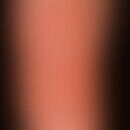Synonym(s)
OccurrenceThis section has been translated automatically.
Field of application/useThis section has been translated automatically.
You might also be interested in
Undesirable effectsThis section has been translated automatically.
Contact allergy to "poison ivy" is the most commonly observed allergy in the United States (poison oak contact dermatitis, rhusdermatitis). It is estimated that 60-80% of the population is sensitized by one or more species of poison ivy. The plant belongs to the family Anacardiaceae, as well as the tree of cashew nut, ginko tree, mango tree and others.
In Europe, the plants are found only in botanical gardens, sensitization, on the other hand, does not play a role in this country. The species cultivated here are the vinegar tree (Stag's cob sumac = Rhus t yphina L.) and even more rarely the wig bush (Cotinus coggygria Scop. = Rhus cotin us L.).
The major allergens are the urushiols. They are the most potent contact allergens occurring in nature. Sensitization potency: Very strong. Sensitization frequency: Very common in the USA, very rare in Europe. Risk of sensitization exists with art objects (wooden jewelry, jewelry boxes), with food (Mango = Mangifera indica L.).
The peels of the mango fruit contain the above-mentioned urushiols. There is no danger in contact with shelled and roasted cashew nuts.
Remark. If there is sensitization to anacardiaceae, traces of urushiols can trigger recurrences. Cross-reactivity exists to chemically related pyrocatechins or other phenols.
Trade namesThis section has been translated automatically.
Poison ivy is represented in the following exteriors: Sanato-Rhev®, Zeel®T Ointment
LiteratureThis section has been translated automatically.
- Crawford GH, McGovern TW (2002) Poison ivy. N Engl J Med 347: 1723-1724
- Hausen BM, Vieluf K (1997) Allergy plants, plant allergens. Ecomed Publishing House Landsberg/Munich 215-218
- Kurlan JG, Lucky AW (2001) Black spot poison ivy: A report of 5 cases and a review of the literature. J Am Acad Dermatol 45: 246-249
- McGovern TW et al. (2000) Is it, or isn't it? Poison ivy look-a-likes. Am J Contact Dermat 11: 104-110
- Oh SH et al (2003) Clinical and immunologic features of systemic contact dermatitis from ingestion of Rhus (Toxicodendron). Contact dermatitis 48: 251-254
- Parkinson G (2002) Images in clinical medicine. The many faces of poison ivy. N Engl J Med 347: 35
- Shelley WB et al (1965) Basophil degranulation induced by oral poison ivy antigen. Arch Dermatol 92: 147-150




